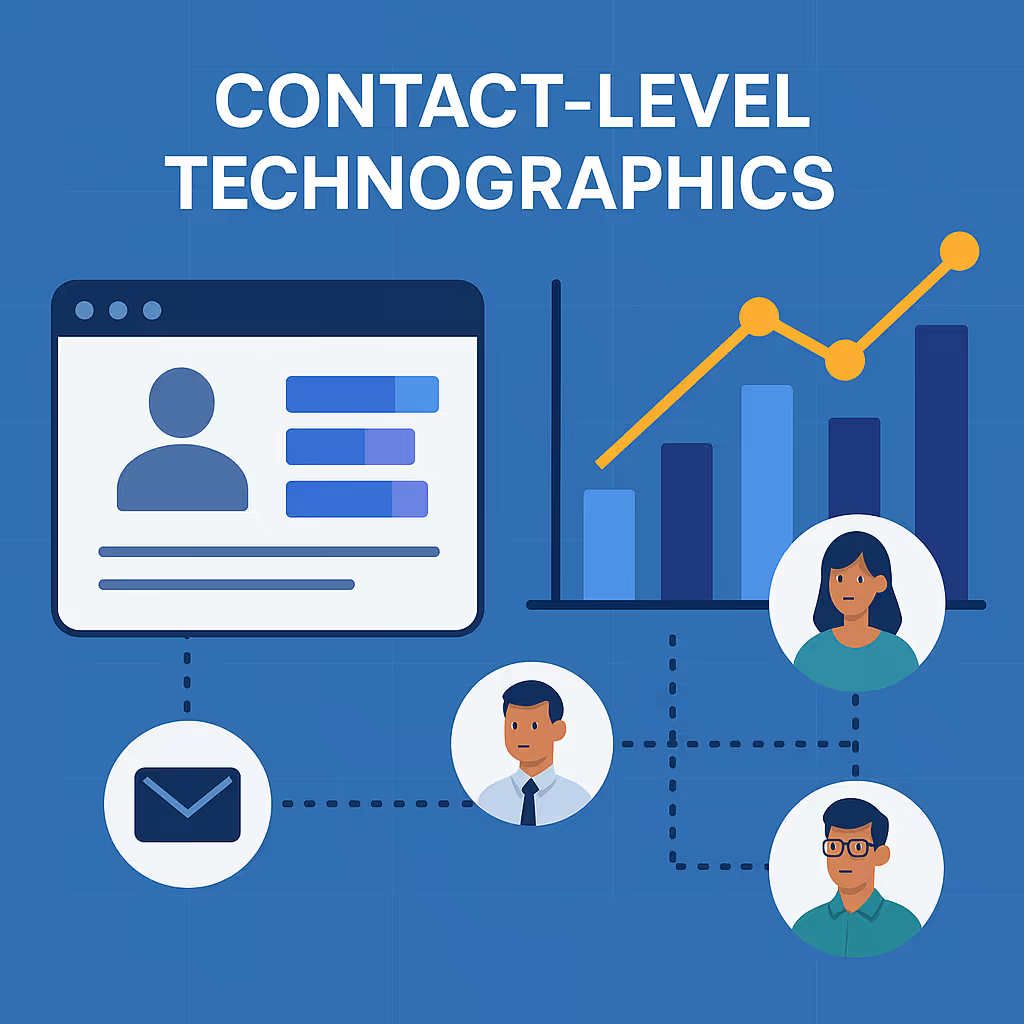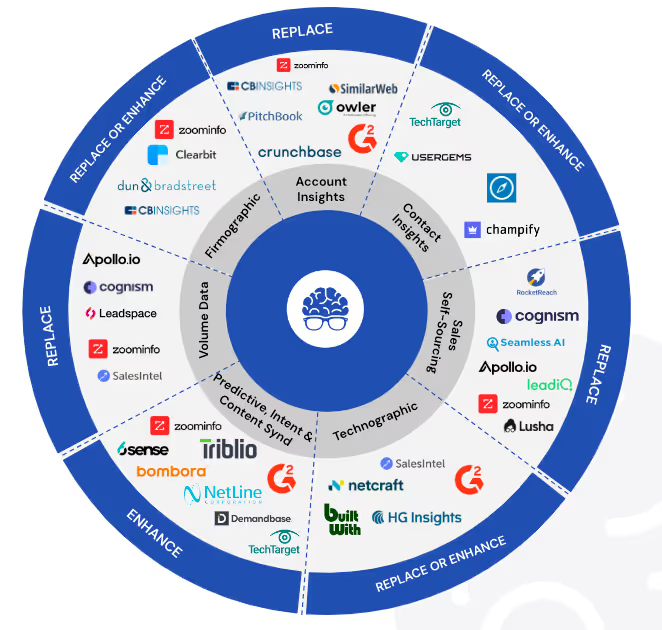B2B sales and marketing are hugely competitive areas – they have to be. After all, finding the right prospects can make or break a company’s success. One key strategy businesses can use to identify and convert high-quality leads is the practice of lead enrichment.
For leaders of marketing, sales, and revenue operations, accessing up-to-date lead data is crucial. When you enrich leads (with firmographics, technographics, and behavioral data, as we’ll explain later), you can improve your outbound efforts significantly to maximize your ROI.
This article will explore the concept of lead enrichment and how you can use it to improve your lead generation efforts. In doing so, you’ll be better able to identify and engage with the prospects who are most likely to convert.
Lead Enrichment: What Is It?
Lead enrichment is the process of supplementing basic lead data with other valuable insights to create a more complete and actionable prospect profile. Generally, lead data is rather basic: a name, email address, or company size. With lead enrichment, you know more about the company – and when you know more, you can do more.
This deeper knowledge may include:
- Firmographics data: Information about the company size, industry, and revenue.
- Technographics data: The technology and tools the company uses – do they use Microsoft? Apple devices? Java? Python?
- Behavioral data: Information about how the company behaves online and how they interact with your company. Do they engage often? Which pages do they visit? Have they signed up to a newsletter? Do they follow you on social media?

The Benefits of Lead Enrichment
For B2B sales and marketing, having this additional knowledge makes a huge difference. The more information you know, the more accurately you can target and personalize your outreach.
It means you’re not treating all of your leads in the same way – a one-size-fits-all approach rarely works well. Having enriched data means you can make meaningful efforts with your leads and you can also save time and resources by prioritizing the ones who are most likely to convert.
When marketing teams can tailor their approach, their messaging becomes more relevant to prospects, as they’re more engaged from the start. When it’s the sales reps time to interact with them, they also have stacks of information to engage with them in a way that resonates. The prospects feel like you’re more in tune with their needs and pain points and are, therefore, much more likely to sign on the dotted line.
If for example, you use a general approach and try to market and sell a piece of software to a lead, you might have some success. But the chances are you’ll have to repeat the same spiel to multiple prospects before you win one over.
You might even spend time discussing options with a lead to then discover their current technology isn’t compatible with what you’re offering. Knowing information about your leads means you don’t fall into the trap of wasting your time (and theirs).
In short, lead enrichment gives businesses a competitive edge. It means you can focus on high-value leads so your teams are the most efficient and effective they can be.

Lead Enrichment in B2B Lead Generation
When you supplement basic contact information with relevant deeper knowledge (e.g., company size, revenue, and the decision-maker’s role), sales and marketing teams have a better idea of whether or not a prospect has potential. A higher level of detail allows teams to use more focused and informed lead generation strategies.
A huge benefit of enriched lead data is the ability to segment leads based on your ideal customer profile criteria. For instance, if your product is designed for large enterprises, knowing a prospect’s firmographic data means you can prioritize larger organizations over smaller ones. Similarly, technographic information can let you know if the prospect is using technology that’s complementary to your product.
Beyond this, lead enrichment means providing a more personalized outreach experience, which helps increase engagement from leads. Marketing teams can focus on developing content that is based on the prospect’s specific industry, challenges, and technology stack.
This means campaigns will be more effective and will have a higher chance of converting. Sales teams, in turn, can use this to approach conversations with a deeper understanding so the dialogue is more relevant to the prospect.
Lead Enrichment Tools and Software
Relying on manual processes for lead enrichment isn’t efficient – or scalable. Lead generation management software plays an important role in automating the process of enhancing lead data. Technology that integrates CRM systems like Rudderstack’s customer data platform with marketing platforms helps enrich raw leads with valuable insights.
Besides the aforementioned data like decision-makers’ roles and industries, you can track industry trends and even buying intent signals. Arguably, one of the biggest advantages of using such software is its ability to access lead information in real-time.
Rather than using static data, lead enrichment software can pull from various sources so that lead profiles stay accurate and actionable. If a lead’s firmographic or technographic information changes over time, you’ll have the latest data to work with.

These platforms also give you the ability to customize processes based on your unique sales and marketing goals. For example, you might want to prioritize high-revenue companies, identify prospects based on a specific software solution, or focus on one industry in particular.
By integrating lead enrichment with lead generation management software, businesses can enhance their lead quality while boosting their overall efficiency. This combination means that marketing and sales teams spend their time effectively on high-value prospects, optimizing outreach efforts and resource allocation at the same time.
How Lead Enrichment Supports Demand Generation
While lead enrichment aids traditional lead generation, it also plays a role in the broader strategy of demand generation. Demand generation is about building brand awareness and creating interest and ‘buzz’. When you use enriched data, you can create highly targeted and personalized outreach.
Personalization leads to success because it resonates with prospects in a meaningful way. It means you can speak directly to their needs and pain points, so they’re more likely to engage with your brand and move closer to a purchasing decision.
Enriched data also helps demand generation teams by way of segmentation. When you understand a lead’s industry, role, and company size, for example, you can develop tailored messaging and show awareness of their challenges so you can nurture them along the sales funnel.
With well-timed and relevant outreach, your prospects will have your brand at the forefront of their minds when they’re considering their options. When lead enrichment is applied to demand generation campaigns in this way, it can be powerful.
Marketing campaigns rely heavily on accurate and up-to-date information and having enriched leads means demand generation efforts can be more strategic and focused. This should result in higher engagement and conversion rates.

Enhancing Sales Performance Through Lead Enrichment
Lead enrichment is just as important for sales teams as it is for marketers. When sales representatives have detailed, up-to-date information on each lead, they are better able to converse with prospects and have a deeper understanding of their needs, challenges, and business environment.
One benefit of lead enrichment for sales is in the prioritization of efforts. Rather than chase down every lead, sales reps can focus on those who are more likely to convert based on their firmographic, technographic, or behavioral data.
For example, if a prospect is actively searching for inbound call handling solutions, having this information readily available means the sales team can highlight the most relevant aspects of their offering so they position their company as the ideal solution for the prospect.
For businesses that rely heavily on email marketing, lead enrichment not only aids in selecting the best tools for campaigns but also helps to tailor content that can make your emails stand out.
Companies looking for Mailchimp alternatives, for instance, can use enriched data to ensure they’re reaching their target audience more effectively.
The insights gained from enriched leads can then inform decisions about email segmentation, personalization, and automation. This results in campaigns that are both more relevant and impactful.
Best Practices for Implementing Lead Enrichment
If you want lead enrichment to be successful for your organization, you need to be strategic about it. Above all else, you need to be working with accurate, relevant, and actionable data. To achieve optimal results, businesses should follow the key best practices outlined below.

- Identify the Most Impactful Data Points
Firstly, identify which specific data points will have the most impact on your sales and marketing efforts. Firmographic and technographic data are valuable but not every piece of information will be equally important.
Quality is better than quantity here. Know your ideal customer profile and concentrate your efforts on collecting data that directly aligns with it. This may be company size, industry, or the current technology used.
When you focus on the most impactful data, you can ensure your lead enrichment efforts are targeted so the insights you then gather will actually improve the quality of your leads.
- Ensure Reliable Data Sources
Without accurate, quality data, you won’t see any benefit. Enriched data is only as good as its sources. Use tools and platforms that provide accurate and up-to-date information.
You might want to use a third-party data provider or integrate enrichment tools with your CRM system. When your teams are always working with the most recent and relevant data, lead profiles become more reliable, increasing the chances of a conversion.
- Maintain Data Hygiene
It’s not enough to enrich your leads once and consider the job done. Data hygiene is essential for best practices in lead enrichment. Data can become outdated quickly, especially for fast-moving industries like technology.
Review and update your enriched lead profiles regularly so you’re not relying on stale information. It may help if you implement automated systems that refresh lead data in real-time, as bad data can become costly.
When your database is accurate, your teams have the best possible insights available to make a real difference to your bottom line.
- Integrate Enriched Data into Workflows
Finally, it’s important to make sure your enriched data is integrated well into your existing sales and marketing workflows. Whether this is through your CRM, lead generation tools, or marketing automation platform, all team members need to be able to access enriched data easily.
With easy access, there is increased efficiency but it also means that sales and marketing teams can be aligned and work from the same high-quality data. This leads to more effective collaboration to convert leads into customers.

Final Thoughts
Lead enrichment is an essential strategy for organizations seeking to improve their lead generation and demand generation efforts. By enriching raw lead data with relevant information and insights, businesses can identify high-quality prospects with increased accuracy. This means they can tailor their outreach better and, ultimately, drive more conversions.
With the best practices we discussed in this guide, businesses can improve the effectiveness of lead enrichment initiatives. When prioritized, these practices create a more targeted and efficient approach, leading businesses to reach their ideal customers.
By investing in lead enrichment, companies position themselves for sustainable growth, improved customer relationships, and a stronger competitive edge. Embrace the power of enriched data and watch your prospecting efforts transform into successful outcomes.




